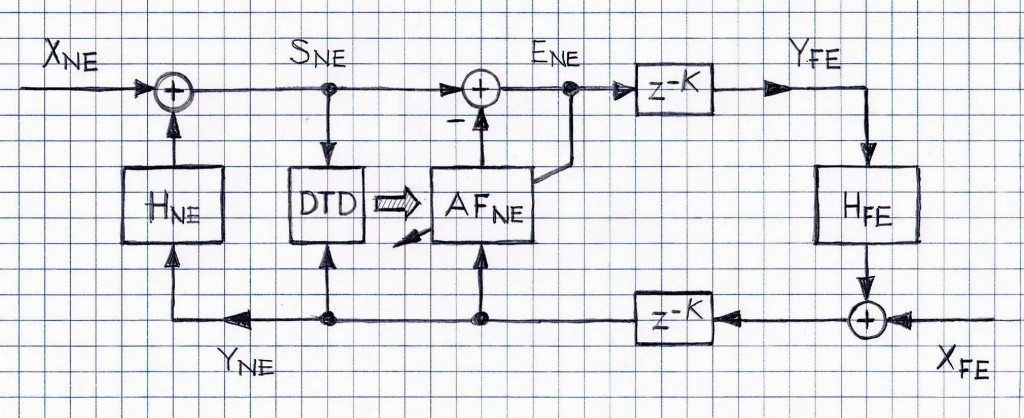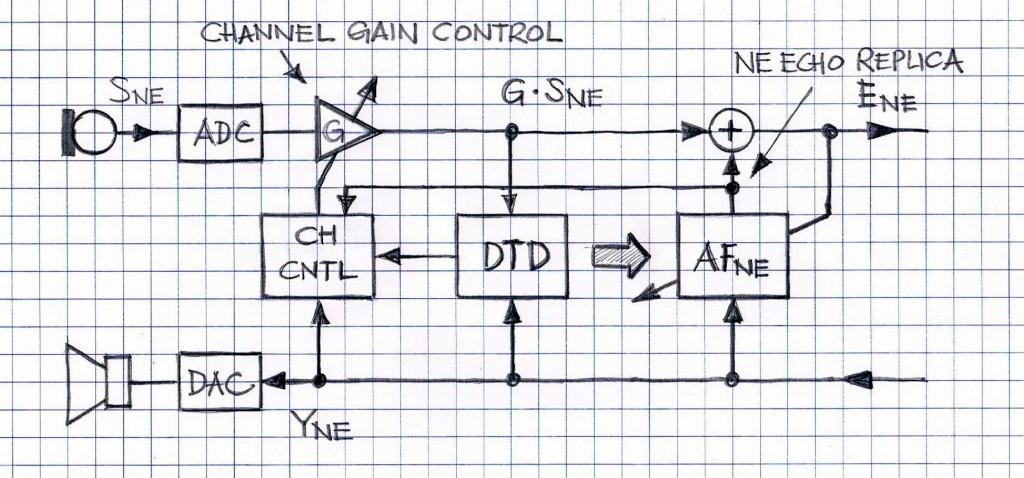The topic of acoustic canceller-based system instability is spread over several aspects of the echo canceller’s adaptive filtering and stability control. In the case of open loop system, when the echo canceller connected at the near end so it addresses the near-end echo (being a line echo or acoustic echo, or both echoes combined), any instability is largely imposed by the stability of the adaptive filter. Selected details regarding the open loop instability, that is adaptive filter instability, are to be covered under a separate note.

A much larger aspect of the topic of stability control of echo canceller based systems is closed loop system stability control. As discussed in [1] and [2], voice channels realized by the closed loop systems are inherently potentially unstable because the transmittance function of the closed loop may have poles outside of the unit circle. If gain and phase of the transmittance function meets conditions for instability (and this situation typically happens for discrete frequencies) then the closed loop voice path manifests high-level oscillations.
In Digital Telephony this effect in known as ‘singing’ (some incorrectly call it ‘howling’; according to the telecommunication standards, ‘howling’ refers to the class of ‘special tones’; the howling tone is used for alerting the end user about the telephone handset left unattended in the off-hook condition). Typical remedies to control singing effect include proper loss plan implementation for telecommunication trunks and lines, which, in essence, include compensational insertion of attenuation (typically though ‘loss pads’) to bring the closed loop into the stability region. These technocrats are used regardless whether the system includes or does not include echo cancellers.
Stability control of closed loop system stability also includes other mitigation techniques such as non-linear signal processing. The fundamental mechanism in these techniques is to break the closed loop oscillation conditions by performing non-linear operations of the signals traveling through the closed loop voice channel. These techniques include, but are not limited to, the following:
- de-correlation
- LP coding/decoding
- signal frequency shift
This is a wide topic and it deserves a separate note. It is only mentioned here for the sake of completeness.
Several examples of addressing the closed-loop stability control through additional features of an echo canceller are discussed. It is worth mentioning that closed-loop stability control in the echo cancellation solution is not mandated by any of the standard requirements. However, it has become an industry requirement – typically, echo canceller users consider closed-loop stability control as one of the desired features of the echo cancellation solution.
One example (outlined in Figure 1) shows an industrial strength solution to address random bursts manifesting under certain conditions (cf. Ref.3). In order to mitigate the instability effect, whose role here goes beyond detecting double talk condition, estimated the equilibrium parameter h computed as an averaged cross-correlation of YNE and SNE, normalized by energy of YNE. Assuming that HFE is a flat gain α (i.e., assuming that the amplitude characteristic of HFE is a constant), then the condition for the avoidance for instability (or, as they call it ‘bursting‘ ) is, as follows.
| α . h | < 1 (1)
Generally speaking, controlling the gain in the send direction and in the receiving direction is a simple and largely effective way of controlling the closed loop stability. References 1 and 2 provide additional support for this observation.

Another example (Figure 2) depicts a closed-loop system where the stability control is implemented via loop gain control (cf. Ref.4).
A more advanced version includes the gain control combined with the adaptation step control. By changing the adaptation step of the adaptive filter algorithm, the adaptation is faster or slower; in case of any signs of the system instability, the adaption speed should be decreased and, if necessary, completely inhibited.
VOCAL Technologies Ltd developed stability control features for echo cancellation can be included in your software product delivery. Contact us to discuss acoustic echo canceller application.
REFERENCES
- ON POTENTIAL INSTABILITY OF NE/FE SYSTEM WITH ECHO CANCELLATION
- ON POTENTIAL INSTABILITY OF NE/FE SYSTEM WITHOUT ECHO CANCELLATION
- FREQUENCY-DEPENDENT BURSTING IN ADAPTIVE ECHO CANCELLATION AND ITS PREVENTION USING DOUBLE_TALK DETECTORS, Ding, Z., Johnson Jr., C.R., and Sethares, W.A., Int. J. of Adapt. Control and Sign. Processing, Vol.4, 219-236, 1990
- Channel control and post filter for acoustic echo cancellation, US Patent 7177416
- STABILITY CONTROL IN A TWO-CHANNEL SPEECH REINFORCEMENT SYSTEM FOR VEHICLES, Ortega, A., et el., September 2005; a version published in IEEE Trans. Speech Audio Processing, vol. 13, no. 5, pp. 917-929, September 2005.